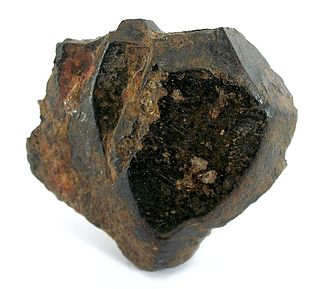
Hematite, also spelled as haematite, is a common iron oxide compound with the formula, Fe2O3 and is widely found in rocks and soils. Hematite crystals belong to the rhombohedral lattice system which is designated the alpha polymorph of Fe
2O
3. It has the same crystal structure as corundum (Al
2O
3) and ilmenite (FeTiO
3). With this it forms a complete solid solution at temperatures above 950 °C (1,740 °F).

Limonite is an iron ore consisting of a mixture of hydrated iron(III) oxide-hydroxides in varying composition. The generic formula is frequently written as FeO(OH)·nH2O, although this is not entirely accurate as the ratio of oxide to hydroxide can vary quite widely. Limonite is one of the three principal iron ores, the others being hematite and magnetite, and has been mined for the production of iron since at least 2500 BCE.

Hematite Township is a civil township of Iron County in the U.S. state of Michigan. As of the 2000 census, the township population was 352. The township is named for the masses of hematite iron ore in the rocks prevalent in the area.

Iron ores are rocks and minerals from which metallic iron can be economically extracted. The ores are usually rich in iron oxides and vary in color from dark grey, bright yellow, or deep purple to rusty red. The iron is usually found in the form of magnetite (Fe
3O
4, 72.4% Fe), hematite (Fe
2O
3, 69.9% Fe), goethite (FeO(OH), 62.9% Fe), limonite (FeO(OH)·n(H2O), 55% Fe) or siderite (FeCO3, 48.2% Fe).

Ilmenite is a titanium-iron oxide mineral with the idealized formula FeTiO
3. It is a weakly magnetic black or steel-gray solid. Ilmenite is the most important ore of titanium and the main source of titanium dioxide, which is used in paints, printing inks, fabrics, plastics, paper, sunscreen, food and cosmetics.

Iron(III) oxide or ferric oxide is the inorganic compound with the formula Fe2O3. It is one of the three main oxides of iron, the other two being iron(II) oxide (FeO), which is rare; and iron(II,III) oxide (Fe3O4), which also occurs naturally as the mineral magnetite. As the mineral known as hematite, Fe2O3 is the main source of iron for the steel industry. Fe2O3 is readily attacked by acids. Iron(III) oxide is often called rust, and to some extent this label is useful, because rust shares several properties and has a similar composition; however, in chemistry, rust is considered an ill-defined material, described as Hydrous ferric oxide.
Black Diamond may refer to:

Meridiani Planum is a plain located 2 degrees south of Mars's equator, in the westernmost portion of Sinus Meridiani. It hosts a rare occurrence of gray crystalline hematite. On Earth, hematite is often formed in hot springs or in standing pools of water; therefore, many scientists believe that the hematite at Meridiani Planum may be indicative of ancient hot springs or that the environment contained liquid water. The hematite is part of a layered sedimentary rock formation about 200 to 800 meters thick. Other features of Meridiani Planum include volcanic basalt and impact craters.

Oolite or oölite is a sedimentary rock formed from ooids, spherical grains composed of concentric layers. The name derives from the Ancient Greek word ᾠόν for egg. Strictly, oolites consist of ooids of diameter 0.25–2 millimetres; rocks composed of ooids larger than 2 mm are called pisolites. The term oolith can refer to oolite or individual ooids.

Martian spherules are the abundant spherical hematite inclusions discovered by the Mars rover Opportunity at Meridiani Planum on the planet Mars in 2004.

Araucarioxylon arizonicum is an extinct species of conifer that is the state fossil of Arizona. The species is known from massive tree trunks that weather out of the Chinle Formation in desert badlands of northern Arizona and adjacent New Mexico and Chemnitz petrified forest in Chemnitz, Germany, most notably in the 378.51 square kilometres Petrified Forest National Park. There, these trunks are locally so abundant that they have been used as building materials.

Red beds are sedimentary rocks, typically consisting of sandstone, siltstone, and shale, that are predominantly red in color due to the presence of ferric oxides. Frequently, these red-colored sedimentary strata locally contain thin beds of conglomerate, marl, limestone, or some combination of these sedimentary rocks. The ferric oxides, which are responsible for the red color of red beds, typically occur as a coating on the grains of sediments comprising red beds. Classic examples of red beds are the Permian and Triassic strata of the western United States and the Devonian Old Red Sandstone facies of Europe.

Hematite is an unincorporated community in eastern Jefferson County, Missouri, United States. It is located approximately seven miles northeast of De Soto.

Aram Chaos, centered at 2.6°N, 21.5°W, is a heavily eroded impact crater on Mars. It lies at the eastern end of the large canyon Valles Marineris and close to Ares Vallis. Various geological processes have reduced it to a circular area of chaotic terrain. Aram Chaos takes its name from Aram, one of the classical albedo features observed by Giovanni Schiaparelli, who named it after the Biblical land of Aram. Spectroscopic observation from orbit indicates the presence of the mineral hematite, likely a signature of a once aqueous environment.

The surface of the planet Mars appears reddish from a distance because of rusty dust suspended in the atmosphere. From close up, it looks more of a butterscotch, and other common surface colors include golden, brown, tan, and greenish, depending on minerals.
Hematite is an unincorporated community in Alleghany County, Virginia, United States.
Irish Pine was a 5,621 GRT cargo ship which was built in 1919 for the United States Maritime Commission (USMC) and named West Hematite. She was chartered in 1941 by Irish Shipping Ltd and renamed Irish Pine. On 16 November 1942, Irish Pine was torpedoed and sunk by U-608.
Hematite is an unincorporated community located in the town of Florence, Florence County, Wisconsin, United States.

The Barrow Hematite Steel Company Limited was a major iron and steel producer based in Barrow-in-Furness, Lancashire, England, between 1859 and 1963. At the turn of the 20th-century and the Technological Revolution it operated the largest steel mill in the world.
Spokane is a ghost town located in Custer County, South Dakota, United States. It was a mining camp in the Black Hills.














